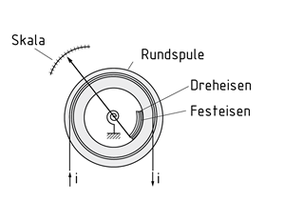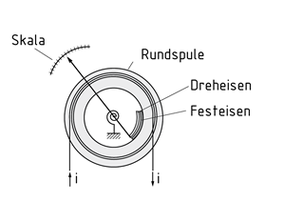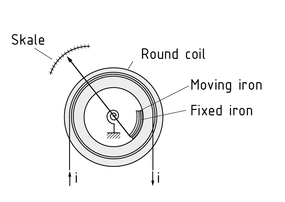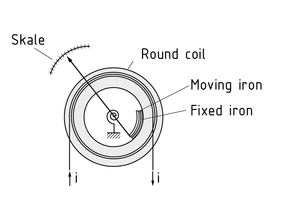
Choose one
or multiple languages
0,1,1
- German
- English
- Chinese
- Spanish
Current measurement

Current measurement records and evaluates the charge carriers per unit of time in a Conductor. The device needed to measure the current intensity is called an ammeter. Both analogue and digital models are available.
During current measurement, a voltage is picked off via a very small built-in shunt. Since the decreasing voltage is proportional to the current, the current intensity can be determined based on an appropriate configuration.
Most analogue measuring instruments have a moving-coil or moving-Iron measuring element. In the case of a moving-iron measuring element, a round coil with a current flowing through it generates a magnetic field, thereby magnetising both the fixed and moving irons. Identical poles repel each other, so the moving iron suspended on a spring via a needle is displaced. Moving-iron measuring elements can be used with direct and alternating currents and always display the rms value.
In the case of a moving-coil measuring element, a current flows through a coil suspended between the poles of a permanent magnet, which makes it try to align itself with the magnet's magnetic field. Moving-coil measuring elements only Work with a Direct current.
The above-mentioned measuring instruments are always connected in series with the current to be measured. The electric circuit needs to be opened for this purpose. If this is not possible, the current intensity can also be measured indirectly, for example using a clip-on ammeter.
Strommessung

Mit einer Strommessung lassen sich die Ladungsträger pro Zeit in einem Leiter erfassen und auswerten. Das zur Messung der Stromstärke benötigte Gerät wird auch als Amperemeter bezeichnet. Amperemeter gibt es in analoger und digitaler Ausführung.
Bei der Strommessung wird über einen eingebauten, sehr kleinen Messwiderstand (Shunt) eine Spannung abgegriffen. Da die abfallende Spannung proportional zum Strom ist, lässt sich nach einer entsprechenden Konfigurierung die Stromstärke bestimmen.
In analogen Messgeräten arbeiten meist ein Drehspulmesswerk oder ein Dreheisenmesswerk. Beim Dreheisenmesswerk erzeugt eine vom Strom durchflossene Rundspule ein Magnetfeld. Dadurch magnetisiert sie das Festeisen und das Dreheisen. Da sich gleichgerichtete Pole abstoßen, wird das über eine Nadel an einer Feder aufgehängte Dreheisen verschoben. Dreheisenmesswerke sind für Gleich- und Wechselstrom verwendbar und zeigen immer den Effektivwert an.
Beim Drehspulmesswerk wird eine zwischen den Polen eines Dauermagneten aufgehängte Spule vom Strom durchflossen, wodurch sie sich am Magnetfeld des Dauermagneten auszurichten versucht. Drehspulmesswerke funktionieren ausschließlich mit Gleichstrom.
Die genannten Messgeräte werden stets in Reihe mit dem zu messenden Strom geschaltet. Hierzu muss der Stromkreis aufgetrennt werden. Ist dies nicht möglich, kann die Stromstärke auch indirekt, zum Beispiel mit einem Zangenamperemeter, gemessen werden.
电流测量

电流测量记录和计算导体中每单位时间的电荷载体。测量电流强度所需的设备称为电流表。可以选择模拟和数字两种型号。
电流测量期间,通过内置分路分流出一个非常小的电压。由于降低的电压正比于电流,并凭借适当的配置来确定电流强度。
大多数类似的测量仪器都有一个动圈式或动铁式测量元件。使用动铁式测量元件时,电流流过圆形线圈并产生一个磁场,磁化了固定和移动铁心。同极发生相互排斥,所以悬挂在弹簧上的指针动铁发生移位。动铁式测量元件可以用于直流与交流电流,且始终显示均方根值。
使用动圈式测量元件时,电流流过永久磁铁两级中悬浮的线圈,这使线圈朝着磁铁磁场的一个方向偏转。动圈式测量元件只能用于直流电流。
上述的测量仪器总是与待测量的电流串联连接。因此,电路需要可以进行外接。如果不能,也可以间接地测量电流强度,例如使用钳形电流表。
动铁式测量仪器的结构
近义词
电流计
动圈式测量元件
动铁式测量元件
钳形电流表
Medición de corriente

La medición de corriente registra y evalúa los portadores de carga por unidad de tiempo en un conductor. El dispositivo necesario para medir la intensidad de la corriente se llama amperímetro Existen tanto modelos análogos como digitales.
Durante la medición de corriente, se mide el voltaje mediante la aguja integrada extremadamente pequeña. Como el voltaje decreciente es proporcional a la corriente, la intensidad de la corriente puede ser determinada según la configuración adecuada.
La mayoría de los instrumentos de medición análogos cuentan con un elemento de medición de bobina móvil o de hierro móvil. En el caso de un elemento de medición de hierro móvil, una bobina redonda con corriente que fluye a través de ella genera un campo magnético, magnetizando así tanto hierros fijos como móviles. Los polos idénticos se repelen entre sí, de manera que el hierro móvil suspendido de un resorte mediante una aguja es desplazado. Los elementos de medición de hierro móvil pueden ser usados con corrientes directas o alternas y siempre muestran el valor rms.
En el caso de un elemento de medición de bobina móvil, la corriente fluye a través de una bobina suspendida entre los polos de un imán permanente, lo que hace que intente alinearse con el campo magnético del imán. Los elementos de medición con bobina móvil solo funcionan con corriente directa.
Los elementos de medición antes mencionados siempre están conectados en serie con la corriente a ser medida. El circuito eléctrico debe estar abierto para este propósito. Si esto no es posible, la intensidad de la corriente también puede ser medida indirectamente, por ejemplo, usando un amperímetro de clip.
Estructura de un instrumento de medición de hierro móvil
